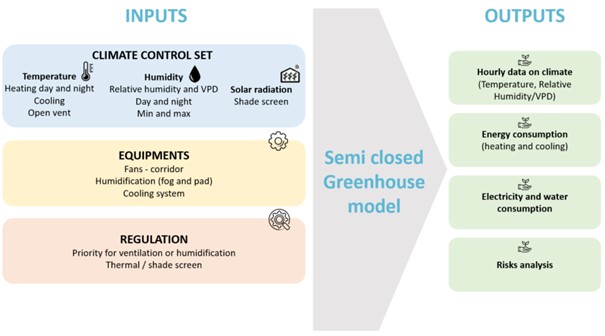How to design a Medicinal Cannabis greenhouse
Medicinal cannabis culture is very technical. It is extremely sensitive to temperature, humidity, lighting and CO2 . Therefore several equipment are needed to regulate the indoor climate: lighting, dehumidification, cooling, heating, black-out screens…
The investments and energy consumptions are very important. The conception of a medicinal cannabis greenhouse is very complicated. A greenhouse’s simulation software helps you to design an energy-efficient greenhouse with an optimized environment. You can simulate multiple scenarios with many different equipment, settings and configurations, and then compare the scenarios to determine the ideal solution. Several software are available such as SIOM, Hortinergy… In this article we will present Hortinergy, an online software, as an example.
1. Climate settings and modelling in a medicinal cannabis greenhouse
You begin by filling the GPS position (to allow the software to generate a weather file), the greenhouse’s dimensions and the types of cover. In a medicinal cannabis greenhouse, you want to be able to control temperatures, humidity, solar radiation, CO2 and air velocity. Software implement all these climate settings parameters:
|
|
Temperature (°C) |
Relative Humidity (%) |
||
|
Min |
Max |
Min |
Max |
|
|
Day |
24 |
28 |
50 |
60 |
|
Night |
20 |
24 |
50 |
60 |
Software simulate usually the transpiration of the medicinal cannabis.
As an illustration we present a glass greenhouse located in Ontario, Canada.
We show the simulation of the indoor climate during an average day in May.


2. Supplementary light design in a medicinal cannabis greenhouse
You can design the supplementary lighting system to adjust lighting level in your greenhouse.
Most of software can model:
- HPS and LED supplementary lighting,
- Solar radiation transmitted by the transparent cover and reaching canopy,
- Supplementary lighting required according to regulation set-points:
- Day Light Integral (DLI),
- or fixed monthly schedule,
- Electricity consumption,
- Impact on the inner climate and energy consumption

3. Heating system and energy consumption in a medicinal cannabis greenhouse design
The programmes simulate the energy consumption of the greenhouse. The results are the hourly heating demands and a monthly synthesis of the energy consumption.


4. Closed greenhouse
Some software can simulate the latent and sensible cooling demand in a closed (or sealed) greenhouse. You enter the maximum day and night temperature and humidity settings.

5. Semi closed greenhouse
Software simulate usaly semi-closed greenhouse. The model includes air tubes, fan specification, air re-circulation rates, pad and fan…

In conclusion, with the help of a greenhouse simulation software, you can achieve innovative and optimal configurations for your medicinal cannabis greenhouse project. Such decision tools give you an impartial evaluation to make the best choices to optimize your investment and reduce your operating costs. For any greenhouse project, contact Hortinergy (contact@hortinergy.com). We look forward to working with you.



